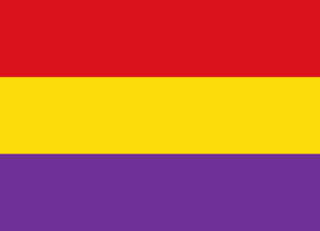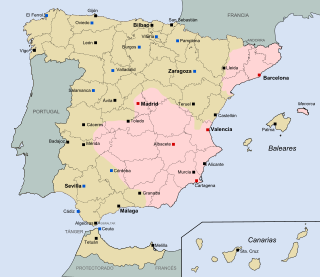
The First Mixed Brigade, also known as Brigada Lister, was a mixed brigade of the Spanish Republican Army in the Spanish Civil War. It was disbanded on 9 February 1939.

The 223rd Mixed Brigade, was a mixed brigade of the Spanish Republican Army in the Spanish Civil War. It was formed in the summer of 1937 from Coastal Defence units and had four battalions, the 889, 890, 891 and 892. This unit lasted until the end of the war.

The 221st Mixed Brigade, was a Mixed Brigade of the Spanish Republican Army in the Spanish Civil War. It was formed in the summer of 1937 in Ciudad Real with four battalions, the 881, 882, 883 and 884.

The 224th Mixed Brigade was a mixed brigade of the Spanish Republican Army in the Spanish Civil War. It was formed in summer 1937 in Catalonia from scattered Coastal Defence units and had four battalions: the 893, 894, 895 and 896.

The 225th Mixed Brigade, was a mixed brigade of the Spanish Republican Army in the Spanish Civil War. It was formed in the summer of 1937 in Valencia with units belonging to the Eastern Coastal Defence and had four battalions, the 897, 898, 899 and 900.

The 227th Mixed Brigade, was a mixed brigade of the Spanish Republican Army in the Spanish Civil War. It was formed in the spring of 1938 in Catalonia and had four battalions, the 905, 906, 907 and 908.

The 11th Division was a division of the Spanish Republican Army in the Spanish Civil War. It was formed in January 1937 in Madrid beginning with the 1st Mixed Brigade which in turn had originated in the Fifth Regiment.

The 228th Mixed Brigade, was a short-lived mixed brigade of the Spanish Republican Army in the Spanish Civil War. It was formed in the last months of the Civil War with battalions belonging to the Carabineros corps. Its first and only leader was the Carabineros Commander Miguel Bascuñana Sánchez.

The 3rd Mixed Brigade, was one of the earliest mixed brigades of the Spanish Republican Army in the Spanish Civil War. It was formed in the fall of 1936 with battalions of the Carabineros corps and saw major action right away in the Defence of Madrid. This brigade also included female combatants —such as Sergeant "La Chata"— and would take part in most of the major battles of the Spanish Civil War, except in the Battle of Jarama.

The 109th Mixed Brigade, was a mixed brigade of the Spanish Republican Army in the Spanish Civil War. It was formed in the spring of 1937 in Utiel with four battalions, the 433, 434, 435 and 436.

The 175th Mixed Brigade, was a mixed brigade of the Spanish Republican Army in the Spanish Civil War. Its number was formerly corresponding to the 10th Santander Brigade, a unit operating in Santander, Spain but was assigned to a new unit in the spring of 1938 in Valencia Province and had four battalions, 697, 698, 699 and 700.

The CXXIX International Brigade or 129th International Brigade was a military unit of the International Brigades during the Spanish Civil War. Its members were from a number of different countries thus it was also known as "Forty Nations Brigade".

The 87th Mixed Brigade, was a mixed brigade of the Spanish Republican Army in the Spanish Civil War. It was formed in March 1937 with battalions of the Carabineros corps. Its first commander was Infantry Colonel Carlos Amores Cantos, who was succeeded by Militia Major Andrés Nieto Carmona.

The 49th Mixed Brigade, was a mixed brigade of the Spanish Republican Army in the Spanish Civil War. It was formed in February 1937 at the Guadalajara Front.

The 84th Mixed Brigade, was a mixed brigade of the Spanish Republican Army in the Spanish Civil War. It was formed in March 1937 with battalions of the Iron Column and was disbanded after the tragic events at Mora de Rubielos that followed the brigade's Battle of Teruel December combats in harsh winter conditions.

The 45th Division was a division of the Spanish Republican Army in the Spanish Civil War.

The 35th Division was a division of the Spanish Republican Army in the Spanish Civil War.

The 66th Mixed Brigade was a unit of the Popular Army of the Republic that participated in the Spanish Civil War. Born in the context of the Battle of Madrid, took part in the Battle of Jarama and the fronts of Guadalajara and Extremadura.(Spanish: 42.ª División) was a division of the Spanish Republican Army in the Spanish Civil War. This unit was involved in the Battle of Jarama —part of the Battle of Madrid, as well as in the Battle of Peñarroya, suffering grievous losses in both battles.

The 17th Mixed Brigade was a unit of the Popular Army of the Republic that participated in the Spanish Civil War. Born in the context of the Battle of Madrid, took part in the Battle of Jarama and the fronts of Guadalajara.(Spanish: 15.ª División) was a division of the Spanish Republican Army in the Spanish Civil War. This unit was involved in the Battle of Jarama —and great part of the Battle of Madrid, suffering grievous losses in both battles.

















